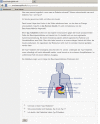Effectiveness of a Web-based tailored interactive health communication application for patients with type 2 diabetes or chronic low back pain: randomized controlled trial
- PMID: 25736340
- PMCID: PMC4376097
- DOI: 10.2196/jmir.3904
Effectiveness of a Web-based tailored interactive health communication application for patients with type 2 diabetes or chronic low back pain: randomized controlled trial
Abstract
Background: The prevalence of chronic diseases such as type 2 diabetes and chronic low back pain is rising. Patient empowerment is a key strategy in the management of chronic diseases. Patient empowerment can be fostered by Web-based interactive health communication applications (IHCAs) that combine health information with decision support, social support, and/or behavioral change support. Tailoring the content and tone of IHCAs to the needs of individual patients might improve their effectiveness.
Objective: The main objective was to test the effectiveness of a Web-based, tailored, fully automated IHCA for patients with type 2 diabetes or chronic low back pain against a standard website with identical content without tailoring (control condition) on patients' knowledge and empowerment.
Methods: We performed a blinded randomized trial with a parallel design. In the intervention group, the content was delivered in dialogue form, tailored to relevant patient characteristics. In the control group, the sections of the text were presented in a content tree without any tailoring. Participants were recruited online and offline and were blinded to their group assignments. Measurements were taken at baseline (t0), directly after the first visit (t1), and at 3-month follow-up (t2). The primary hypothesis was that the tailored IHCA would have larger effects on knowledge and patient empowerment (primary outcomes) than the control website. The secondary outcomes were decisional conflict and preparation for decision making. All measurements were conducted by online self-report questionnaires. Intention-to-treat (ITT) and available cases (AC) analyses were performed for all outcomes.
Results: A total of 561 users agreed to participate in the study. Of these, 179 (31.9%) had type 2 diabetes and 382 (68.1%) had chronic low back pain. Usage was significantly higher in the tailored system (mean 51.2 minutes) than in the control system (mean 37.6 minutes; P<.001). Three months after system use, 52.4% of the sample was retained. There was no significant intervention effect in the ITT analysis. In the AC analysis, participants using the tailored system displayed significantly more knowledge at t1 (P=.02) and more emotional well-being (subscale of empowerment) at t2 (P=.009). The estimated mean difference between the groups was 3.9 (95% CI 0.5-7.3) points for knowledge and 25.4 (95% CI 6.3-44.5) points for emotional well-being on a 0-100 points scale.
Conclusions: The primary analysis did not support the study hypothesis. However, content tailoring and interactivity may increase knowledge and reduce health-related negative effects in persons who use IHCAs. There were no main effects of the intervention on other dimensions of patient empowerment or decision-related outcomes. This might be due to our tailored IHCA being, at its core, an educational intervention offering health information in a personalized, empathic fashion that merely additionally provides decision support. Tailoring and interactivity may not make a difference with regard to these outcomes.
Trial registration: International Clinical Trials Registry: DRKS00003322; http://apps.who.int/trialsearch/Trial2.aspx?TrialID=DRKS00003322 (Archived by WebCite at http://www.webcitation.org/6WPO0lJwE).
Keywords: Internet; Type 2 diabetes mellitus; back pain; health communication; randomized controlled trial.
Conflict of interest statement
Conflicts of Interest: NW, JD, and MH were among the developers of the intervention.
Figures
References
-
- Hoy Damian, Bain Christopher, Williams Gail, March Lyn, Brooks Peter, Blyth Fiona, Woolf Anthony, Vos Theo, Buchbinder Rachelle. A systematic review of the global prevalence of low back pain. Arthritis Rheum. 2012 Jun;64(6):2028–37. doi: 10.1002/art.34347. http://dx.doi.org/10.1002/art.34347 - DOI - DOI - PubMed
-
- Danaei Goodarz, Finucane Mariel M, Lu Yuan, Singh Gitanjali M, Cowan Melanie J, Paciorek Christopher J, Lin John K, Farzadfar Farshad, Khang Young-Ho, Stevens Gretchen A, Rao Mayuree, Ali Mohammed K, Riley Leanne M, Robinson Carolyn A, Ezzati Majid, Global Burden of Metabolic Risk Factors of Chronic Diseases Collaborating Group (Blood Glucose) National, regional, and global trends in fasting plasma glucose and diabetes prevalence since 1980: systematic analysis of health examination surveys and epidemiological studies with 370 country-years and 2·7 million participants. Lancet. 2011 Jul 2;378(9785):31–40. doi: 10.1016/S0140-6736(11)60679-X. - DOI - PubMed
-
- Wild Sarah, Roglic Gojka, Green Anders, Sicree Richard, King Hilary. Global prevalence of diabetes: estimates for the year 2000 and projections for 2030. Diabetes Care. 2004 May;27(5):1047–53. - PubMed
-
- Becker Annette, Held Heiko, Redaelli Marcus, Strauch Konstantin, Chenot Jean F, Leonhardt Corinna, Keller Stefan, Baum Erika, Pfingsten Michael, Hildebrandt Jan, Basler Heinz-Dieter, Kochen Michael M, Donner-Banzhoff Norbert. Low back pain in primary care: costs of care and prediction of future health care utilization. Spine (Phila Pa 1976) 2010 Aug 15;35(18):1714–20. - PubMed
-
- Freburger Janet K, Holmes George M, Agans Robert P, Jackman Anne M, Darter Jane D, Wallace Andrea S, Castel Liana D, Kalsbeek William D, Carey Timothy S. The rising prevalence of chronic low back pain. Arch Intern Med. 2009 Feb 9;169(3):251–8. doi: 10.1001/archinternmed.2008.543. - DOI - PMC - PubMed
Publication types
MeSH terms
Associated data
LinkOut - more resources
Full Text Sources
Other Literature Sources
Medical




